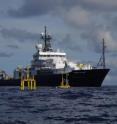Inaugural deployment of buoys to measure air and sea interactions in typhoons launched from Taiwan
An international team of scientists and technicians from the University of Miami (UM) Rosenstiel School, the University of Leeds in the United Kingdom, Woods Hole Oceanographic Institution, and Environment Canada are participating in a groundbreaking buoy deployment that will help them to better understand interactions between the ocean and atmosphere during typhoons. The research is funded by the U.S. Office of Naval Research. The R/V Revelle, a Scripps research vessel departed from the port of Kao-hsiung, Taiwan with two tandem buoy sets onboard: the boat-shaped EASI (Extreme Air-Sea Interaction) buoy and the ASIS (Air-Sea Interaction Spar) buoy. This is the first time these buoys will be used in the typhoon-prone Western Pacific. In the past, these buoy deployments have taken place in the Atlantic Ocean during hurricane season, and on separate experiments in the Southern Ocean and Labrador Sea.
The researchers are deploying the two sets of buoys in tandem, about � miles southeast of Taiwan to thoroughly test them in typhoon force conditions. The buoys will be out at sea for 3 months collecting valuable data that scientists will use to understand the exchange dynamics and fluxes occurring between the atmosphere and ocean during the intense typhoon conditions.
"We have successfully used these buoys to measure air-sea interactions and wave dynamics in the Atlantic in a variety of storm conditions and are now looking forward to applying this technology to the western Pacific where super typhoons develop quite frequently," said the PI of this project, Dr. Hans Graber, professor and executive director of UM's Center for Southeastern Tropical Advanced Remote Sensing. "In the last several years we have added new technologies and improved the data collection capabilities of these buoys as well as made the buoys more robust to withstand extreme weather conditions. In addition we will also be using satellite telecommunications to query the buoys routinely from Miami and retrieve data. "
The buoys will measure the momentum, heat, and moisture exchange between the air atmosphere and ocean at the midst of tropical cyclones. This information will help improve weather forecast models that predict typhoon intensity. It will also give the research community a better idea of the distribution of wind and how force is distributed. There will be sonic anemometers (acoustic devices that measure wind speed and stress at high resolution) and a suite of other sensors that measure air temperature, humidity, and water temperature. The buoys will also have ADCPs (acoustic Doppler current profilers) to measure currents as a function of depth, as well as temperature probes in the upper ocean and acoustic devices to measure turbulence near the surface. A strong set of piano-like wires arranged in a pentagon will measure small scale details of the ocean surface (roughness) and the directional properties of waves.
"The buoys feature a Compact Lightweight Aerosol Spectrometer (CLASP) device that measures the near-surface marine aerosol production mechanisms, or sea spray from wave-breaking events that result from typhoon force winds," said Dr. Will Drennan, UM professor and associate dean of undergraduate studies for the Rosenstiel School. "These measurements could be especially important as the spray layer has a significant impact on the drag coefficient, a key parameter used in creating weather forecast models."
Source: University of Miami Rosenstiel School of Marine & Atmospheric Science
Other sources
- Deployment of buoys to measure air and sea interactions in typhoons launched from Taiwanfrom Science DailyWed, 11 Aug 2010, 3:35:34 UTC
- Buoy deployment to study Pacific stormsfrom UPITue, 10 Aug 2010, 23:35:19 UTC
- Inaugural deployment of buoys to measure air and sea interactions in typhoons launched from Taiwanfrom Science BlogTue, 10 Aug 2010, 17:35:25 UTC
